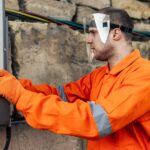Severe weather can wreak havoc on homes, particularly on roofs, which bear the brunt of high winds, heavy rain, hail, and debris. For homeowners in Fort Wayne, IN, understanding how to properly assess and repair storm damage is crucial. Effective storm damage repair not only restores the safety and integrity of your roof but also helps prevent future problems. Here are essential steps to take when your roof has been affected by a storm.
Step 1: Safety First
Before attempting any inspection or repair, ensure your safety. After a storm, hazards such as loose shingles, broken glass, and exposed nails can pose serious risks. If you suspect major damage, especially structural, it’s best to wait for a professional to perform the initial assessment. Do not attempt to climb on the roof if it’s severely damaged or during inclement weather.
Step 2: Document the Damage
Once it’s safe to do so, documenting the extent of the storm damage is your next step. This can be done using a camera or smartphone. Take clear photos or videos from different angles, capturing details of the damage. This documentation is crucial for insurance claims and for contractors to better understand the repairs needed.
Step 3: Temporary Measures to Mitigate Further Damage
If the damage is extensive, consider temporary measures to protect your property from further harm. Covering broken areas with tarps or securing loose shingles can prevent water from entering the home and causing interior damage. However, ensure that any temporary fixes are safely applied and are only intended as short-term solutions until professional repairs can be made.
Step 4: Contact Your Insurance Company
Contact your homeowner’s insurance provider to report the damage and understand your coverage for storm damage repair. Provide them with the documentation you’ve gathered. Many insurance policies cover storm damage, and your provider will guide you through the claims process. They may also request an inspection by a claims adjuster to verify the damage and determine the coverage amount.
Step 5: Choose a Qualified Storm Damage Repair Contractor
Selecting the right contractor is critical for effective storm damage repair. Look for a local roofing company with experience in storm damage assessments and repairs. Ensure they are licensed and insured, and check their references or reviews from other homeowners in Fort Wayne. A reputable contractor will offer a transparent quote and explain the necessary repairs in detail.
Step 6: Detailed Roof Inspection
A professional roofing contractor will conduct a detailed inspection to assess the full extent of the damage. This includes looking for signs of water infiltration, checking the condition of roofing materials, and evaluating structural issues. The inspection should cover both the exterior aspects of the roof and the interior conditions of the attic or ceiling where leaks might be present.
Step 7: Repair Plan and Execution
Once the inspection is complete, the contractor should provide a comprehensive plan for repairing the storm damage. This plan should outline the materials and techniques to be used, a timeline for the repair work, and an estimate of the cost. During the repair process, a good contractor will keep you updated on progress and any changes in the plan.
Step 8: Final Inspection and Maintenance Plan
After the repairs are completed, conduct a final walk-through with the contractor to ensure that all agreed-upon work has been completed to your satisfaction. Also, discuss a maintenance plan to keep your roof in good condition, which can help mitigate future storm damage.
Conclusion
Dealing with storm damage can be a daunting task, but taking the right steps can simplify the process and ensure that your roof is repaired properly. By prioritizing safety, documenting the damage, understanding your insurance coverage, and choosing a skilled storm damage repair contractor, you can restore your roof effectively and efficiently. Remember, a well-maintained roof not only protects your home from future storms but also adds to its long-term value and safety.







